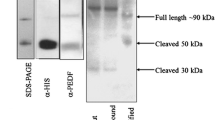Abstract
We have recently found that pigment epithelium-derived factor (PEDF), a glycoprotein with potent neuronal differentiating activity, not only inhibits endothelial cell damage, smooth muscle cell proliferation and platelet aggregation in vitro, but also suppresses occlusive thrombus formation in rats. These observations suggest PEDF may play a protective role against atherothrombosis. However, effects of PEDF on hemostasis, fibrinolysis and platelet function in vivo are not fully understood. In this study, we examined the effects of PEDF on tail vein bleeding time, plasminogen activator inhibitor-1 (PAI-1) activity and ex vivo-platelet aggregation in rats. Intravenous injection of 30 μg PEDF significantly prolonged the tail vein bleeding time by about 25%. Administration of 30 μg PEDF was also found to reduce the PAI-1 activity in rats. Further, ADP-induced platelet aggregation was suppressed in PEDF-treated rats. The present study demonstrated first that PEDF exerted anti-hemostatic effects in rats, at least in part by suppressing PAI-1 activity and platelet aggregation. PEDF may be a novel therapeutic target for the treatment of patients with thrombogenic tendency and hypercoagulability.

Similar content being viewed by others
References
Takenaka K, Yamagishi S, Matsui T, Nakamura K, Imaizumi T (2006) Role of advanced glycation end products (AGEs) in thrombogenic abnormalities in diabetes. Curr Neurovasc Res 3:73–77
Takenaka K, Yamagishi S, Matsui T, Nakamura K, Jinnouchi Y, Yoshida Y, Ueda S, Katsuki Y, Katsuda Y, Imaizumi T (2008) Pigment epithelium-derived factor (PEDF) administration inhibits occlusive thrombus formation in rats: a possible participation of reduced intraplatelet PEDF in thrombosis of acute coronary syndromes. Atherosclerosis 197:25–33
Tombran-Tink J, Barnstable CJ (2003) PEDF: a multifaceted neurotropic factor. Nat Rev Neurosci 4:628–636
Yamagishi S, Inagaki Y, Nakamura K, Abe R, Shimizu T, Yoshimura A, Imaizumi T (2004) Pigment epithelium-derived factor inhibits TNF-alpha-induced interleukin-6 expression in endothelial cells by suppressing NADPH oxidase-mediated reactive oxygen species generation. J Mol Cell Cardiol 37:497–506
Yamagishi S, Nakamura K, Matsui T, Inagaki Y, Takenaka K, Jinnouchi Y, Yoshida Y, Matsuura T, Narama I, Motomiya Y, Takeuchi M, Inoue H, Yoshimura A, Bucala R, Imaizumi T (2006) Pigment epithelium-derived factor inhibits advanced glycation end product-induced retinal vascular hyperpermeability by blocking reactive oxygen species-mediated vascular endothelial growth factor expression. J Biol Chem 281:20213–20220
Nakamura K, Yamagishi S, Matsui T, Yoshida T, Takenaka K, Jinnouchi Y, Yoshida Y, Ueda S, Adachi H, Imaizumi T (2007) Pigment epithelium-derived factor inhibits neointimal hyperplasia after vascular injury by blocking NADPH oxidase-mediated reactive oxygen species generation. Am J Pathol 170:2159–2170
Yamagishi S, Inagaki Y, Amano S, Okamoto T, Takeuchi M, Makita Z (2002) Pigment epithelium-derived factor protects cultured retinal pericytes from advanced glycation end product-induced injury through its antioxidative properties. Biochem Biophys Res Commun 296:877–882
Freedman JE, Sauter R, Battinelli EM, Ault K, Knowles C, Huang PL, Loscalzo J (1994) Deficient platelet-derived nitric oxide and enhanced hemostasis in mice lacking the NOSIII gene. Circ Res 84:1416–1421
Yamagishi S, Adachi H, Abe A, Yashiro T, Enomoto M, Furuki K, Hino A, Jinnouchi Y, Takenaka K, Matsui T, Nakamura K, Imaizumi T (2006) Elevated serum levels of pigment epithelium-derived factor in the metabolic syndrome. J Clin Endocrinol Metab 91:2447–2450
Yamagishi S, Adachi H, Takeuchi M, Enomoto M, Furuki K, Matsui T, Nakamura K, Imaizumi T (2007) Serum level of advanced glycation end-products (AGEs) is an independent determinant of plasminogen activator inhibitor-1 (PAI-1) in nondiabetic general population. Horm Metab Res 39:845–858
Vaughan DE (2005) PAI-1 and atherothrombosis. J Thromb Haemost 3:1879–1883
Acknowledgments
This study was supported in part by Grants of Venture Research and Development Centers from the Ministry of Education, Cultures, Sports, Science and Technology, Japan (S. Y.).
Conflict of interest statement
The authors declare that they have no conflict of interest related to the publication of this manuscript.
Author information
Authors and Affiliations
Corresponding author
Rights and permissions
About this article
Cite this article
Yamagishi, S., Matsui, T., Nakamura, K. et al. Administration of pigment epithelium-derived factor prolongs bleeding time by suppressing plasminogen activator inhibitor-1 activity and platelet aggregation in rats. Clin Exp Med 9, 73–76 (2009). https://doi.org/10.1007/s10238-008-0010-4
Received:
Accepted:
Published:
Issue Date:
DOI: https://doi.org/10.1007/s10238-008-0010-4




